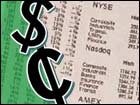
NEW YORK (CNN/Money) - With all the accounting worries, the lingering terrorist threat, and the near-daily pain of watching your portfolio bleed, it's hard to find a reason to hang onto stocks these days.
But here's one: According to at least one popular way of looking at the market, stocks are the cheapest they've been since early 1996.
The "Fed stock valuation model" shows that the S&P 500 is about 27 percent below where it should be. Besides a brief period after Sept. 11, this is the first time the indicator has flashed "undervalued" since the Russian debt crisis of 1998.
What is the model?
The Federal Reserve doesn't actually endorse this tool -- it was dubbed the "Fed model" by Prudential Securities strategist Ed Yardeni after a Fed report to Congress in July 1997 suggested the bank was following it.
And versions of the Fed model have long been a staple on Wall Street. Doug Cliggott, who until early this year was J.P. Morgan's strategist (and who was the only strategist at a major Wall Street firm who forecast stocks would lose ground in 2002) uses a variation, as does Byron Wien, the widely-respected Morgan Stanley strategist.
The model compares the 10-year Treasury note and the S&P 500, with the idea that the expected return of the two competing investments should be more or less the same.
The Treasury's return is easy -- it's the yield, the annual return investors get if they hang on until the note's maturity.
The equivalent for stocks is the "earnings yield," or expected earnings divided by price. It's just the inverse of the more common price/earnings (P/E) ratio, and tells you how much in earnings you can expect to get for each dollar you pay.
If stock prices go up by more than expected earnings, the earnings yield falls. If it drops below the Treasury yield, the theory goes, stocks are overvalued. (Why buy risky stocks if they're returning less than Treasurys that are virtually risk-free?)
Hey, it works ...
Enough with the theory. The real reason to pay attention to the Fed model is that, over time, it's been pretty good at calling the market. In August 1987, for example, it showed stocks were overvalued by 35 percent. Three months later the market crashed.
For a long stretch in the early 1990s -- from 1993 through early 1996 -- it indicated that stocks were undervalued. The model also advised selling before the selloffs in 1997 and 1998.
|
 |  | Date� |  | Fed model says stocks are...� |  | S&P 500, 3 months later� |  | Aug. 1987� | 34% overvalued� | down 30%� |  | Oct. 1998� | 10% undervalued after the Russian debt crisis� | up 16%� |  | May 1999� | 37% overvalued, more than 1987� | up 1%� |  | Mar. 2000� | 52% overvalued at the bubble's peak� | down 4%� |  | Sept. 2001� | 10% undervalued� | up 10%� |  | Now� | 17% undervalued� | ?� |
|  |  |
| �Source:��Prudential Securities |
|
And it also suggested getting out before March 2000 (though admittedly, it was a little early). In the spring of 1999, the model showed that valuations had swollen to levels in excess of summer 1987. By March 2000 it put overvaluation at 50 percent.
Investors should keep that experience of 1999 and early 2000 in mind when looking at the model. "The model is not a market timing tool," cautions Yardeni. "Stocks could stay undervalued for a while."
A false read?
There are other potential problems with the model.
For one, it relies on earnings estimates, and estimates are almost always too high, according to Salomon Smith Barney economist Steven Wieting. He reckons growth in the next four quarters will be 13.2 percent -- strong, but well shy of the consensus for 22.5 percent growth. (On the plus side, Wieting points out that forecasts are always too high, which means that excessive optimism may already be reflected in the current Fed model reading.)
A bigger worry is quality of earnings. Recent scrutiny over accounting practices appears to have put companies on better behavior -- but there's still plenty of room for improvement.
"They've been getting a little bit better," says Howard Silverblatt of Standard & Poor's quantitative research group, "but they're still not as clean as they used to be." With less faith in earnings, you have to put less faith in the Fed model.
That said, there have been other times when people decided that the logic behind the Fed model was flawed. Remember the 1999 book Dow 36,000? Its central argument was that stocks were no longer substantitally riskier than bonds, which meant that stocks' earnings yield could be lower than bond yields. For a while there, people believed it.

|

